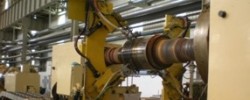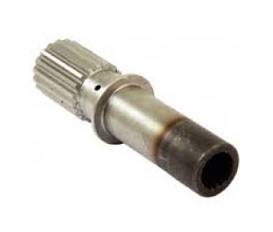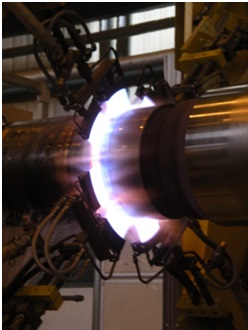Combining the Best of Both Worlds

So far we’ve covered applications for progressive flame hardening machines and spin hardening machines (The Beauty Of Spin Hardening) . It’s possible to combine these two methods when hardening cylindrically shaped parts that need progressive heating and quenching to cover large areas of a length too long for traditional spin hardening.

Parts that benefit most from this combination design include:
• Steel and Aluminum mill rolls (where just the bearing surfaces at the neck are hardened)
• Hydraulic cylinders
• Embossing rolls
• Extremely large rolls and shafts, for example mill rolls of 50,000-60,000 lbs
A combination method machine (Combination Flame Hardening Video) turns the roll or shaft on a lathe-like mechanism in a horizontal position. Torches scan the surface with water-quenched flame heads while the roll is spinning. The beauty of combining progressive and spin hardening is really twofold: 1) it allows for extremely economical flexibility by accommodating a wide range of diameters with only a few flame heads; and 2) it can produce an enormous amount of heat, evenly distributed, without requiring expensive power units to translate the power source into BTUs.
Economical flexibility is, of course, a hallmark of flame hardening solutions. If you’re tooling with segmented burner solution, maybe 3 or 4 sets of flame heads, you can do unlimited incremental changes in diameter from 2 to 40 inches. Your size is limited only by length of the lathe in the machine. In addition to the economy of scale in part size accommodation, flame hardening can generate a lot of heat relatively inexpensively in comparison to similarly equipped induction machines. That’s how we can harden larger parts more economically – fuel and oxygen can generate a lot of heat over a large mass without any kind of special power units. To add more heat, you simply add more torches and the controls that mix and maintain proper ratios. We don’t have to create special mechanisms to transform the power source into heat. This translates into significant cost savings when you’re dealing with large applications.
Flame hardening also provides cost savings to the customer because the cost of our machines can be much lower than heat induction. Then you add the built-in flexibility where you can scale down or up in the amount of heat and quench in the combination method, only by adding or taking away additional flame heads and torches. The design of these incremental changes means a lot of cost savings for you. When dealing with bigger parts needing a lot of heat, combination flame hardening makes it more controllable and repeatable – hallmarks of induction heating — but at a fraction of the purchase price.
Next week we’ll get into some really good wonk stuff for you flame hardening geeks: flame head design for both heat and quench. Flame heads are the heart of flame hardening machines, where the heat (and sometimes quench) meets the steel or iron parts exactly where they need to be hardened. As always, if you have any heat treating question about your application, and particularly if you are using or considering using flame hardening for case hardening, give me a call at 919-956-5208 or email mark@flametreatingsystems.com.
B19: We would like to know your opinion.







